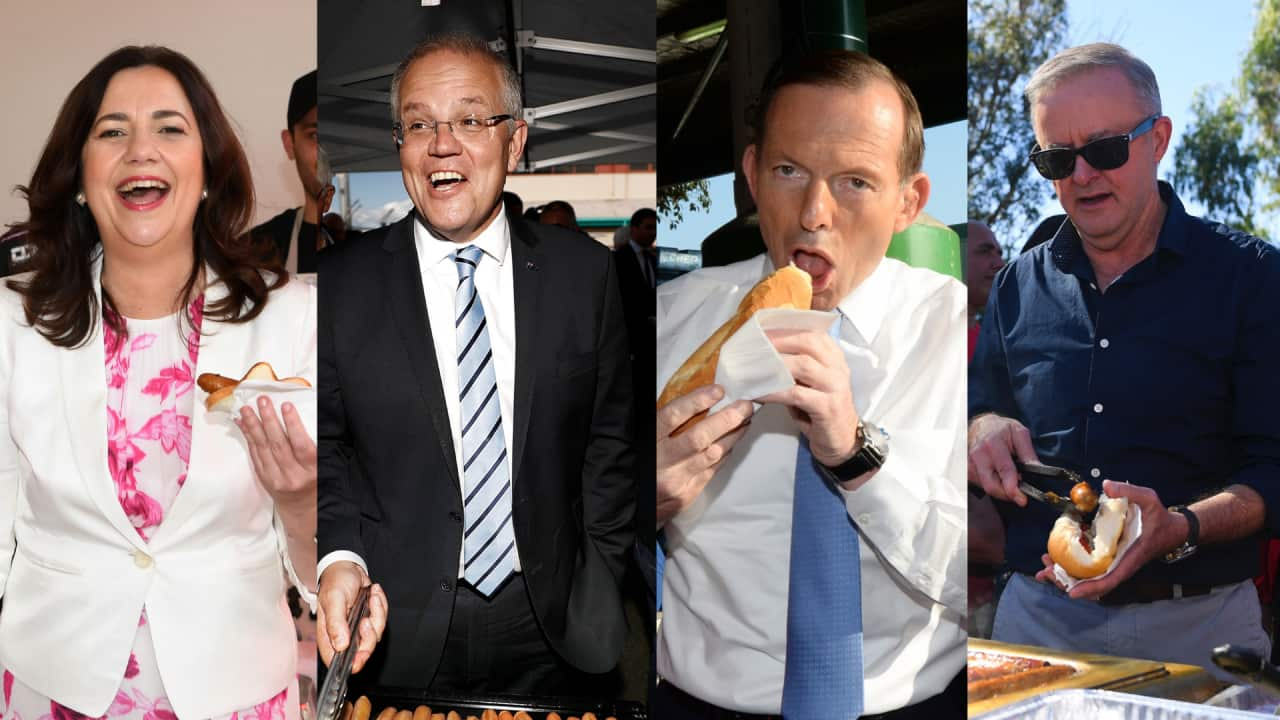It's election day, and just when you thought you'd met your quota of big decisions, you're faced with some others: bun or sliced bread? Tomato, mustard or barbecue? Onion or no onion?
For some, deciding what trimmings and toppings decorate their sausage sandwich may vex them more than deciding how they stack the candidates.
With most voters casting their ballot paper around midday, you could speculate it’s well timed around the enjoyment of the democracy sausage.

Former prime minister Tony Abbott eats a sausage as he tours Kalgoorlie, Western Australia, during the 2010 election campaign. Source: AAP / DEAN LEWINS/AAPIMAGE
Professor Brett's 2019 book on how Australia embraced compulsory voting titled: From Secret Ballot to Democracy Sausage: How Australia Got Compulsory Voting, explains the election snag's ascent over time.
Ninety-two per cent of enrolled voters had their say in the 2019 election, making Australia a country with one of the highest voter turnouts in the world.
As Professor Brett explains in her book, barbecues and cake stalls at polling stations have played a big part in giving election day an atmosphere of celebration.

Former Greens leader, Richard Di Natale, bites into a sausage from a primary school sausage sizzle after casting his vote on 2 July 2016. Source: AFP / PAUL CROCK/AFP via Getty Images
In an interview with CNN in 2019, Professor Brett said there's a long history of linking election day with food in Australia.
"Certainly, there's a photo in the 1930s of a polling booth with a cake stall outside, so I think community organisations saw it was an opportunity to fund-raise," she said in the interview.
By the 1980s, the popularity of portable gas barbecues saw the classic sausage sizzle become a common feature of community gatherings and, of course, election days.
"At the 2010 Queensland election some Brisbane friends set up a website for groups to register their election-day fundraising offerings," Professor Brett writes in her book.

Scott Morrison cooks sausages during a Liberal party campaign rally at Launceston Airport in April 2019 in Launceston. Credit: Ryan Pierse/Getty Images
It was a hit, with Twitter and Facebook accounts born soon after. A map linking polling places to food stalls came next.
By 2011, the election sausage sizzle came to be known as the "democracy sausage", and in 2016, it was crowned the Australian National Dictionary Centre's word of the year.
The origins of the term are obscure, but a handful of tweets carrying the #democracysausage hashtag popped up in 2010.
The term and the sizzle are so widespread Twitter has adjoined a sausage sizzle emoji to the Ausvotes22 hashtag.
Have there been notable democracy sausage gaffes? Yes, there have, Professor Brett points out in her book. In 2016, former Labor leader Bill Shorten took a bite from the centre of a roll, furrowing the brows of many.
"Clearly, social media concluded, he had never grabbed his weekend breakfast at Bunnings."

Former Labor leader Bill Shorten bites the middle of a roll at Strathfield North Public School in Sydney in 2016. Credit: Lisa Maree Williams/Getty Images
"He too had shown himself to be no ordinary bloke," Professor Brett writes.
Now, democracysausage.org has taken the role of collating the locations, marking all the stalls set to crop up on election day. On its interactive map, there's icons denoting sausages, cake, coffee, bacon and egg burgers, with halal and vegetarian options, too.
The website was created on the eve of the 2013 state election in Western Australia after Annette Tyler tweeted for fellow voters to share locations and photos of sausage sizzles with the hashtag #democracysausage.
Pictures came pouring in, encouraging Annette, who works in data management, and friends to compile the crowd-sourced information. Now, a small team of volunteers has been plotting locations for the federal election.
Its Facebook profile reads in part: "A map of sausage and cake availability on election day. Why? It's practically part of the Australian Constitution. Or something."
Annette expects there to be about a 1 to 3 ratio of stalls to polling places on the day, noting some locations only see a small number of voters.
How many sausages will be sold? Hundreds of thousands, she estimates.
Sometimes people get creative, gracing cake stalls with Malcolm Turnovers, Bill Shorternbreads and Jacqui Lambingtons in 2016.

A poster listing the offerings from a stall at a previous election shared by the @DemSausage Twitter.
"It's very Australian, isn't it? Loving a sausage sizzle?" Annette tells The Feed.
"Around election time, things can become very divided with who you're gonna vote for and one thing everyone can get behind is the democracy sausage."
On one tour of democracy sausage stalls in 2019, Annette ate four servings for the cause, sporting her "democracy sausage" shirt on some occasions, which garnered some attention.
"It's kind of nice to be the one that everybody likes on the day."










